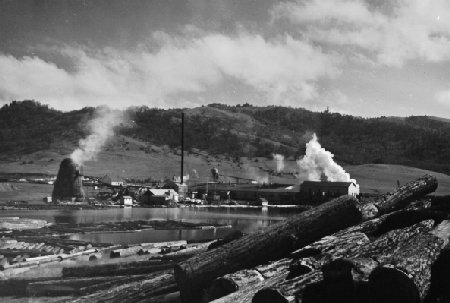Kerf
I bet you don't know what kerf is. Well, today let's find out. The University of Houston's College of Engineering presents this series about the machines that make our civilization run, and the people whose ingenuity created them.
Think about the labor of sawing a log into lumber. Then it'll be clearer why pioneers built log cabins. Think about the labor of just sawing off a tree limb. Then compare that with slicing a log lengthwise, again and again, to make boards.
As soon as medieval millwrights harnessed water power to grind grain, they turned around and made water-powered saws to cut wood. They had to make mills to cut wood, to make more mills to grind grain. (Have you got that? There will be a test.)
Now, if you cut off a tree limb, you don't chew much wood into sawdust. But slice a log into boards, and the loss adds up fast. The width of a saw cut is called kerf. That's an Anglo-Saxon word related to our word carve. The kerf of a lumber saw -- the width of its cut -- might be 3/8 of an inch. Make 50 lengthwise cuts in a 4-foot diameter log, and you waste a lot of wood.
Wood was dirt cheap in mid-19th-century America. So we made fast saws with a wide kerf -- like half an inch. Then we choked on the resulting sawdust. We used sawdust to fuel the donkey engines that drove the saws. We burned it to keep log ponds from freezing in winter. We burned it just to get rid of it. And still sawdust fires destroyed logging mills with tedious regularity.
So kerf was a huge problem. After all, a saw is a metal plate. It has to be wide enough to keep from buckling, and the teeth must be wider still if they're to cut.
Now, another problem: saw teeth work efficiently in only one direction. You don't cut on the return stroke. In 1777 an Englishman patented a circular saw. Circular saws are fast, and their kerf is reasonable. Of course they use a lot of power.
An American legend says that a Shaker lady, Sister Tabitha, had a vision. The action of a saw and a spinning wheel merged. She realized that a rotating disk would make the sawing motion continuous. That story could be true. America didn't take up circular saws until 1814. By then, our Shaker communities were very active.
Finally, the matter of veneer. We used to make veneer by sawing millimeter-thick sheets. Kerf made that very costly. In 1840 we find an American patent for a knifelike device that peels a log like an apple and yields a continuous thin sheet of wood. No kerf at all! It was 1870 before practical veneer cutters were in use, and it was WW-I before we layered veneer to make plywood.
I moved to the lumber town of Roseburg, Oregon, in 1946. It was a land of huge conical iron slash and sawdust burners. Particle board was still a material of the future. Everywhere, sawdust went up in smoke. We heated our house with it. The sweet smell permeated the county. I didn't know the word kerf yet. I lived only for a season in all the sawdust it produced.
I'm John Lienhard, at the University of Houston, where we're interested in the way inventive minds work.
(Theme music)
Elliott, C.D., Technics and Architecture: The Development of Materials and Systems for Buildings. Cambridge, MA: The MIT Press, 1992, Chapter 1, Wood.
Andrews, E.D., The Community Industries of the Shakers. Philadelphia: Porcupine Press, Inc., 1972.

Photo by James Lienhard
Burning slash and sawdust at a lumber mill near Roseburg, Oregon, in 1946